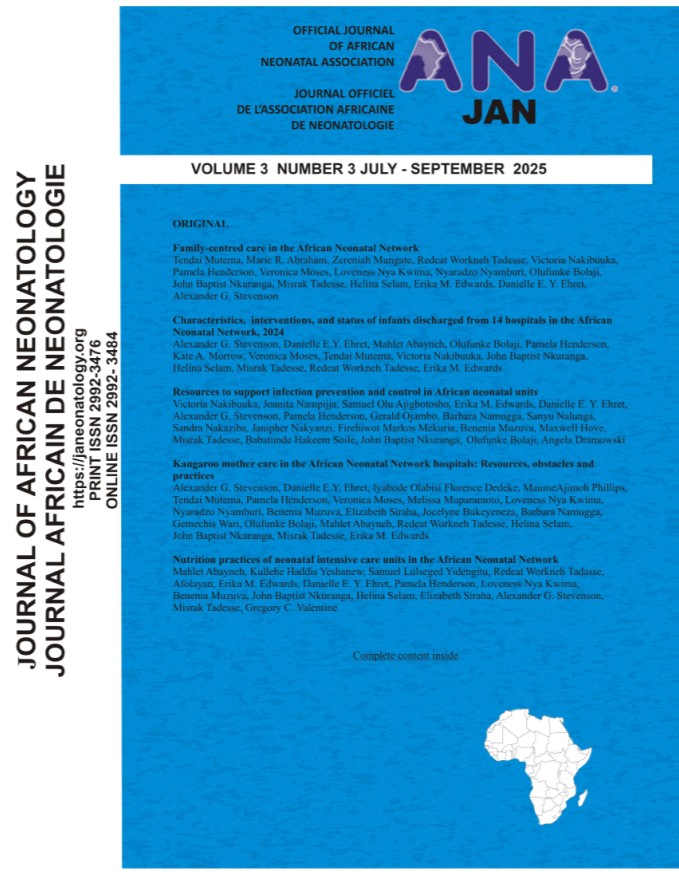Service levels and infrastructure in 14 African Neonatal Network hospitals
Keywords:
Infant, Newborn; Infant, Premature; Neonatal Intensive Care Units; Hospitals / organization and administration; Health Facilities/standards; Health Resources; Health Equipment and Supplies; Medical Equipment; Africa South of the Sahara; Global HealthAbstract
Background: Hospitals across Africa are diverse in terms of infrastructure, available medical technology, and the range of services provided. Many hospitals in Africa face ongoing challenges related to inadequate equipment, frequent breakdowns due to poor
maintenance, and irregular supplies of commodities.
Methods: Fourteen hospitals in the African Neonatal Network responded to an annual facility survey and a health facility survey co-developed by faculty in the African Neonatal Network and Vermont Oxford Network. All analyses use descriptive statistics.
Results: The hospitals varied in service level and included a mix of public, private, and faith-based institutions mostly located in cities or large towns. The median total bed capacity was 34. The median annual deliveries across the hospitals were 3583 (Q1:1800,
Q3:4369).All hospitals reported being able to provide continuous positive airway pressure, supplemental oxygen via nasal cannula, essential newborn care and neonatal resuscitation at delivery, kangaroo mother care, intravenous antibiotics, prevention of mother-to-child HIV transmission, and supplemental feeds via cup or nasogastric tube.
Conclusions: The 14 hospitals reported experiencing shortages of necessary equipment, beds, technicians, medications, and tests, similar to other hospitals in low- and middle-income countries. Reducing neonatal mortality to meet the United Nations’ Sustainable Development neonatal mortality goal of 12 per 1,000 live births by 2030 will require significant investment in neonatal units, as it is likely that the demand for services will only continue to grow.
References
UN IGME. Levels & Trends in Child Mortality: Report 2023, Estimates developed by the United Nations Interagency Group for Child Mortality Estimation, United Nations Children’s Fund. New York; 2024.
Edwards EM, Ehret DEY, Soll RF, Horbar JD. Vermont Oxford Network: a worldwide learning community. Transl Pediatr. 2019; 8(3): 182-192
Dickson KE, Simen-Kapeu A, Kinney MV, Huicho L, Vesel L, Lackritz E, et al. Every Newborn: health-systems bottlenecks and strategies to accelerate scale-up in countries. Lancet. 2014 Aug 2;384 (9941):438–54.
Moxon SG, Guenther T, Gabrysch S, Enweronu-Laryea C, Ram PK, Niermeyer S, et al. Service readiness for inpatient care of small and sick newborns: what do we need and what can we measure now? Journal of Global Health. 2018 Jun;8(1):010702.
World Health Organization. Survive and thrive: transforming care for every small and sick newborn [Internet]. Geneva: World Health Organization; 2019
Makene C, Plotkin M, Currie S, Bishanga D, Ugwi P, Louis H, et al. Improvements in newborn care and newborn resuscitation following a quality improvement program at scale: Results from a before and after study in Tanzania. BMC pregnancy and childbirth. 2014 Nov 19;14:381.
Tarus A, Msemo G, Kamuyu R, Shamba D, Kirby RP, Palamountain KM, et al. Devices and furniture for small and sick newborn care: systematic development of a planning and costing tool. BMC Pediatrics. 2023 Nov 15;23 (2):566.
World Health Organization. Equipment, Supplies, Drugs, and Laboratory Tests. In: Pregnancy, Childbirth, Postpartum and Newborn Care: A Guide for Essential Practice 3rd edition. World Health Organization; 2015.
World Health Organization. Web Annex B. World Health Organization Model List of Essential Medicines for Children – 9th List, 2023.Geneva: World Health Organization; 2023.
Narayanan I, Nsungwa-Sabiti J, Lusyati S, Rohsiswatmo R, Thomas N, Kamalarathnam CN, et al. Facility readiness in low and middle-income countries to address care of high risk/ small and sick newborns. Maternal Health, Neonatology and Perinatology. 2019 Jun 18;5(1):10.
Herbert H, Lee A, Chandran A, Rudan I, Baqui A. Care Seeking for Neonatal Illness in Low- and Middle-Income Countries: A Systematic Review. PLoS medicine. 2012;9:e1001183.
Kinshella MLW, Hiwa T, Pickerill K, Vidler M, Dube Q, Goldfarb D, et al. Barriers and facilitators of facility based kangaroo mother care in sub-Saharan Africa: a systematic review. BMC Pregnancy and Childbirth. 2021;21 (1):176.
World Health Organization. Standards for improving the quality of care for small and sick newborns in health facilities. Geneva; 2020.
Jarrett O, Gim D, Puusepp‐ Benazzouz H, Liu A, Bhurawala H. Factors contributing to neonatal readmissions to a level 4 hospital within 28 days after birth. Journal of Paediatrics and Child Health. 2022;58(7):1251.
Kaur E, Heys M, Crehan C, Fitzgerald F, Chiume M, Chirwa E, et al. Persistent barriers to achieving quality neonatal care in low-resource settings: perspectives from a unique panel of frontline neonatal health experts. Journal of Global Health Reports. 2023;7:e2023004.
NEST360. Newborn Essential Solutions and Technologies- Education – Technical Modules: Point-of-Care Diagnostics: Glucometer. 2021.
Downloads
Published
Issue
Section
License
Copyright (c) 2025 JOURNAL OF AFRICAN NEONATOLOGY

This work is licensed under a Creative Commons Attribution-NonCommercial-ShareAlike 4.0 International License.
This is an open-access journal, and articles are distributed under the terms of the Creative Commons Attribution-NonCommercial-ShareAlike 4.0 License, which allows others to remix, tweak, and build upon the work non-commercially, as long as appropriate credit is given and the new creations are licensed under the identical terms.

